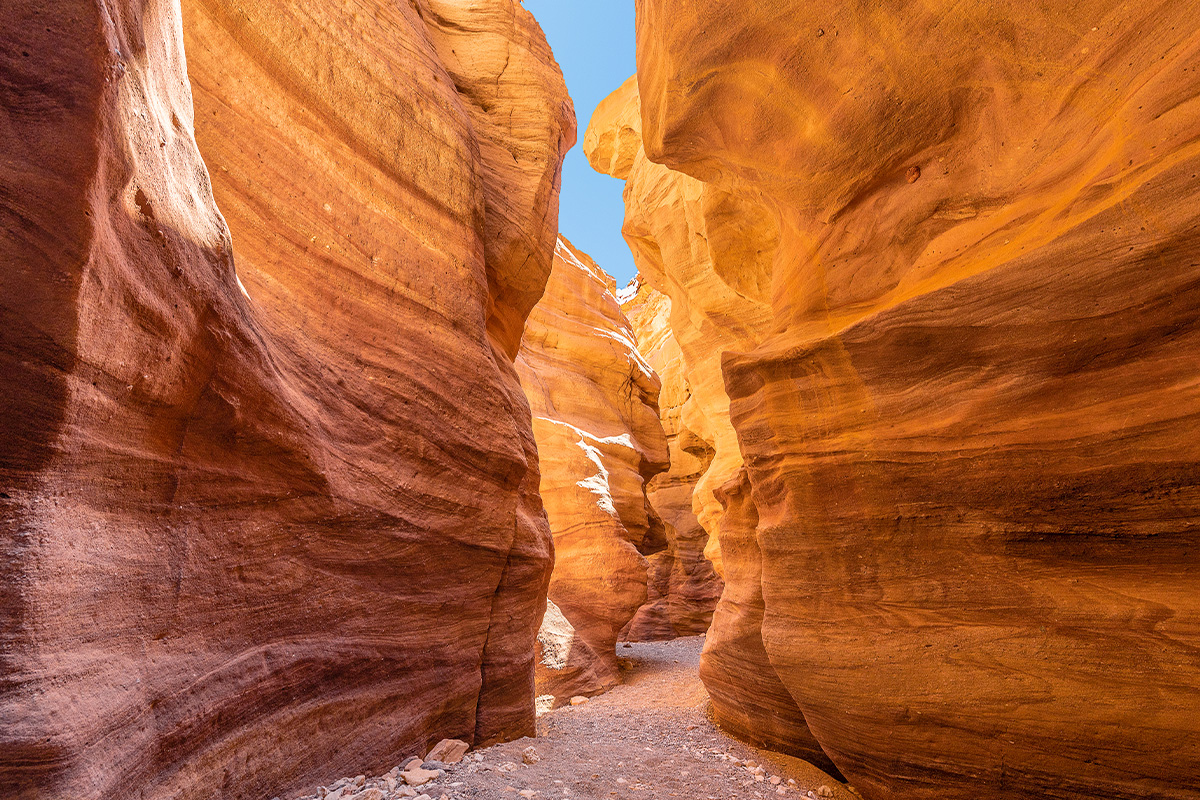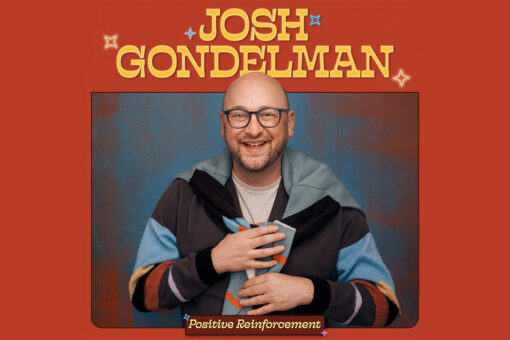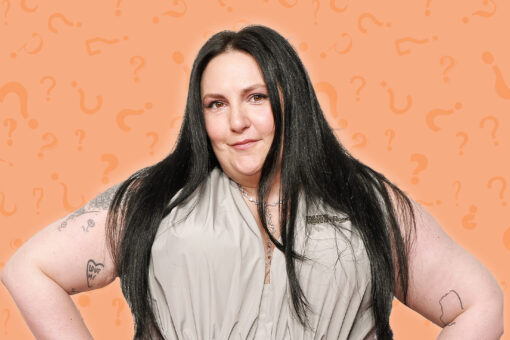It was, in many ways, exactly as I remembered — listening to the creak of my backpack against my shoulders and waving aside brush and morning spiderwebs.
Every couple of minutes, I’d spot another trail blaze: three vertical stripes of white, blue, and orange. They were staggered, with orange reaching highest — meaning I was headed south, away from snow-capped Mount Hermon and toward the sands of the Negev.
I returned to Israel in May 2022, mainly to visit my sister but also to bookend the strangeness of the last few years. A part of me imagined I could pick up where I left off, in late 2019 and in a world before the pandemic, when I spent two-and-a-half months walking the Israel National Trail. I’d joined a hiking group I found online, mostly Israelis on either side of their army service or their studies, plus some intrepid retirees. They shared trail mix with me under hard-sought shade, pistachios and dried apricots sticky with sugar, as we talked in English and my stumbling Hebrew.
There were so many days I wanted to recreate. The closer I got to this trip, the faster the memories surfaced: the morning we wound through green hills toward Jerusalem, the afternoon of the bell caves, the night I found a scorpion in my backpack (though that I’d rather not relive). I wanted to visit the hidden springs and the pomegranate orchards and the clunky-hooved ibex in the Ramon Crater.
In the end, logistics won out: While my sister was in class, I’d spend Tuesday on the trail, beginning in Ein Hod, an artist colony south of Haifa where her boyfriend could drop me on his way to work. 24 kilometers later, at a junction outside Zichron Yaakov, I’d catch the 826 bus that returned to Tel Aviv every hour on the :13.
That morning, standing in a grassy parking lot, I buckled my backpack and found the three stripes, painted at eye level on a telephone pole. It was early and the trail was hushed, the air golden and smelling of hay. My boots shed their stiffness as I set off among the olive trees, weaving between their wizened trunks, nearly bouncing with the thrill of being back.
Soon I met two other hikers. We compared routes (Where did you start? Where are you stopping?) and they suggested I download a navigation app, one my phone told me I’d used back in 2019 though in the time since I had completely forgotten. It’s helpful, they said, just in case. Sometimes it’s hard to see the markers.
As I walked I tried to place this particular day among all the others. When had I last seen these beekeeper boxes? This picnic table under the pines?
Then the trail merged with a dirt road, rocky and the color of red clay. It was the road that finally reminded me. Back in 2019, I’d been walking along it with Tamar and Tal when a pickup truck came trundling along, seemingly without a care for the bumps or the narrowness of the path. The driver stopped to say hello. His name was Benny and he worked for the electric company. He was on his way to Zichron Yaakov, which was our destination, too. Did we need anything? he wanted to know.
Tamar asked if he had gum. Gum! Of course! He passed some around. He insisted we must be thirsty, so he got out of the truck and poured us water from a cooler. We chewed our gum and drank our water and chatted in the kind of familial way that’s only possible in such a small country. If I had walked in on the scene, I would’ve sworn we were all friends, enjoying a happy run-in.
A few months later I’d return home to New York and COVID-19 would hit, and the days would be marked not by water breaks and chance encounters but by ambulance sirens and rising case counts. I couldn’t make sense of the shift. Not long ago, it had been possible to hike the length of an entire country — past ancient ruins and city streets, through forests that overlooked the honey-blue of the Mediterranean, deep into the sharpness of the desert.
At the height of the pandemic, these felt like relics of another lifetime. How had the world been so expansive, so wide open?
I walked in stale circles around my neighborhood, and I pictured the trail, empty but unflappable, waiting in a hibernation of sorts — trampled wildflowers righting themselves and wind smoothing over footprints, the quiet coating everything like a salve.
Looking back at my notebook from the hike, I could pinpoint the exact day I’d happened upon this past May — September 24, 2019. Turns out, the story didn’t end there. That evening, camping on the outskirts of Zichron Yaakov, a few of us planned to head into town for dinner. As we debated how to get there — walk? bus? — a pickup truck pulled over. A familiar driver waved. This time we were friends enjoying a happy run-in. We crammed into the backseat and Benny started the car.
Now, more than two years later, I was approaching the end of that same day. The trail climbed to the top of a hill, and I sat on a boulder to rest. Below lay a patchwork of fields, a town in the distance, everything lush after a winter of rain.
It reminded me of my last day of hiking in 2019. The mountains there were taller, the view of Eilat and its palm trees, its kite surfers buoyed by the wind. I could see the end of the trail. Then, like now, I was in no rush to leave.
I came here before the pandemic at a crossroads, a point of change and uncertainty in my own life, hoping the hike would arm me with clarity for whatever lay ahead — with no idea, of course, that we were barreling toward March 2020.
And yet for two-and-a-half months, I’d found a purpose measured in kilometers and the meditation and joy of going somewhere. I felt the sun on my face every day, this delicious tiredness in my legs every day — unlacing my boots and shaking out the dust, setting up my tent, preparing to start again tomorrow.
In Judaism we say a blessing when we do something for the first time, an appreciation for arriving at that singular, fleeting moment. But the clock resets every year: We say shehechiyanu on the first day of holidays that occur annually, for instance. So this is not just a blessing for first times, but for seconds and thirds and fourths, for doing something you’ve already done but with new context and new perspectives, that only the passage of time — especially this time — can bring.
I thought about that blessing, and about the years that divided one hike from the next. They had confined us in more than space and time; they’d also held us back from each other. Could the trail of September 24 — the generosity of its strangers, the way the world felt bright and boundless — still exist in 2022?
Then I remembered the Israelis I’d met that morning, and I smiled — because I was so grateful to live this again, and because on the other side of a pandemic, both everything and nothing had changed.
I’d hiked with the two of them for some time, making small talk as we went, until they paused to take a break. They set down their packs and rummaged for a snack. I decided to keep walking, so I scanned the path for the three stripes and downloaded the navigation app, just in case. We said goodbye.
Before I continued on my way, one of them asked, in the spirit of Benny: Do you need a hat?



